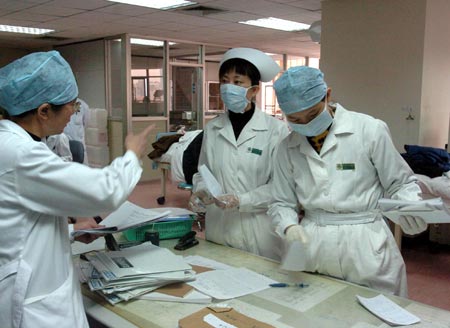At the end of 2006, China had 300,000 health institutions, including 59,000 general hospitals and health centers, 3,006 maternity and child-care institutions, and 1,404 specialized health institutions. The number of epidemic disease prevention centers (stations) stood at 3,587 and that of health monitoring institutions came to 2,256. There were 4.525 million health workers in the country, consisting of 1.97 million practicing doctors and assistant practicing doctors and 1.386 million certified nurses. The number of beds in general hospitals and health centers stood at 3.216 million. The number of township health centers stood at 40,000, with 680,000 beds and a staff of 857,000. Throughout the year, 3.489 million people were infected by Class-A or B infectious diseases, with 10,623 reported deaths. The incidence rate was 266.84 per 100,000 and the mortality rate was 0.81 per 100,000. Across the country, 1,451 counties (cities and districts) established the new cooperative medical care system on a pilot basis, accounting for 50.7 percent of the country's total counties (cities and districts), and covering 410 million farmers, with a participation rate of 80.5 percent.
 |
China has a long way to go to reform the medical system.
Prevention and Control of Major Diseases
In 2006, the State Council promulgated the Regulations on AIDS Prevention and Control, providing a legal guarantee for the work. The prevention and control of major infectious diseases such as AIDS, tuberculosis, snail fever and hepatitis B have been listed in the outlines of the country's 11th Five-Year Plan for Social and Economic Development (2006-10).
Great strides were made in the building of a nationwide information network on infectious diseases and public health incidents in the year, which remarkably raised the efficiency of infectious disease prevention and control. Throughout China, 93 percent of general hospitals above the county level and 70 percent of township health centers are now able to report outbreaks of infectious diseases and public health incidents directly to health authorities via the Internet.
In 2006, health authorities enhanced efforts to prevent and treat such chronic diseases as high blood pressure, cardio- and cerebral-vascular diseases, diabetes and malignant tumor. Great progress was achieved to raise public awareness of health issues and expand the coverage of community-based health services.
Key Points of Medical Work in 2007
The Ministry of Health detailed key aspects of medical work in 2007 as: focusing on the building of a basic medical service system, promote the sound development of rural, community-based and public health services; deepen the reform of the medical system; enhance hospital management and improve the quality of medical workers; and reduce costs of medical services and provide patients with easier access to doctors.
First, the policy of prevention and control of major infectious diseases at the government's expense will be continued. In addition to HIV/AIDS, tuberculosis and snail fever, medications for leprosy that is of good therapeutic effect will also be given for free. Second, the building of the new rural cooperative medical care system will be accelerated. In 2007, the pilot program of this system will be expanded to cover more than 80 percent of the country's counties (cities and districts). Third, more efforts will be given to expand the coverage of the pilot program of the basic medical insurance for urban residents. Beginning from 2007, besides workers and staff members of enterprises and institutions, all other urban residents will be included in this system. The central finance will offer subsidies to needy urban residents in central and western regions who can hardly afford the required premiums. Fourth, more medical aid will be offered to both urban and rural residents. In 2007, the central finance will continue to increase input in the improvement of the rural medical aid system in central and west China. Efforts will also be made to steadily push forward the pilot program of urban medical aid and to promote the standardization and institutionalization of the medical aid work in both urban and rural areas to gradually enhance the level of related services. Fifth, support for the improvement of grassroots health care will be greatly enhanced. The goal is to train all medical workers in rural areas and urban communities by 2010, mainly at the expense of central and local governments. Sixth, the drive to revitalize traditional Chinese medicine will be pushed forward, with incremental support to the program of "prestigious doctors, departments and hospitals." Traditional Chinese medicine will be given a push in grassroots medical institutions, to bring into full play its unique advantages. At the same time, the supervision over food and drug sectors will also be enhanced.
In 2007, the central finance will allocate 31.276 billion yuan to the health care work, an increase of 14.536 billion yuan or 86.8 percent over that in 2006.






